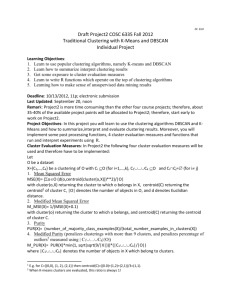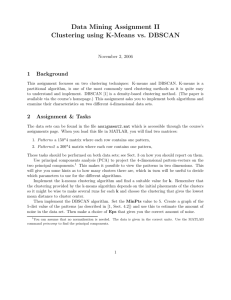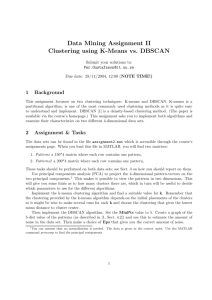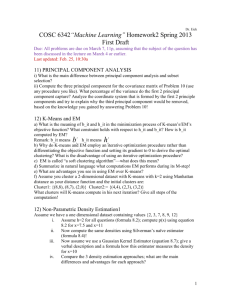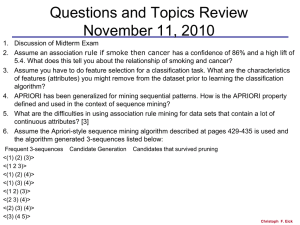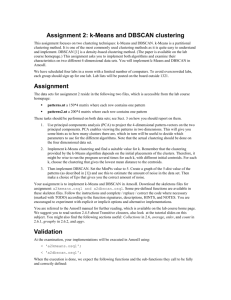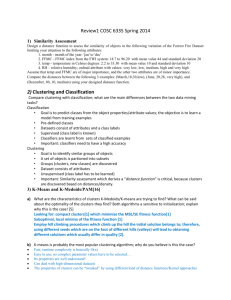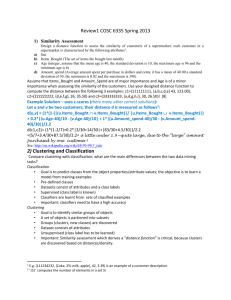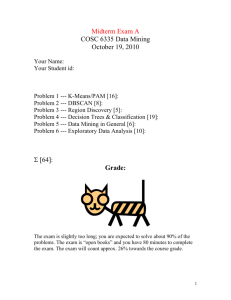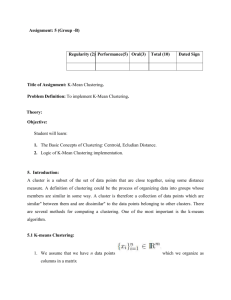Project2: Clustering with K
advertisement
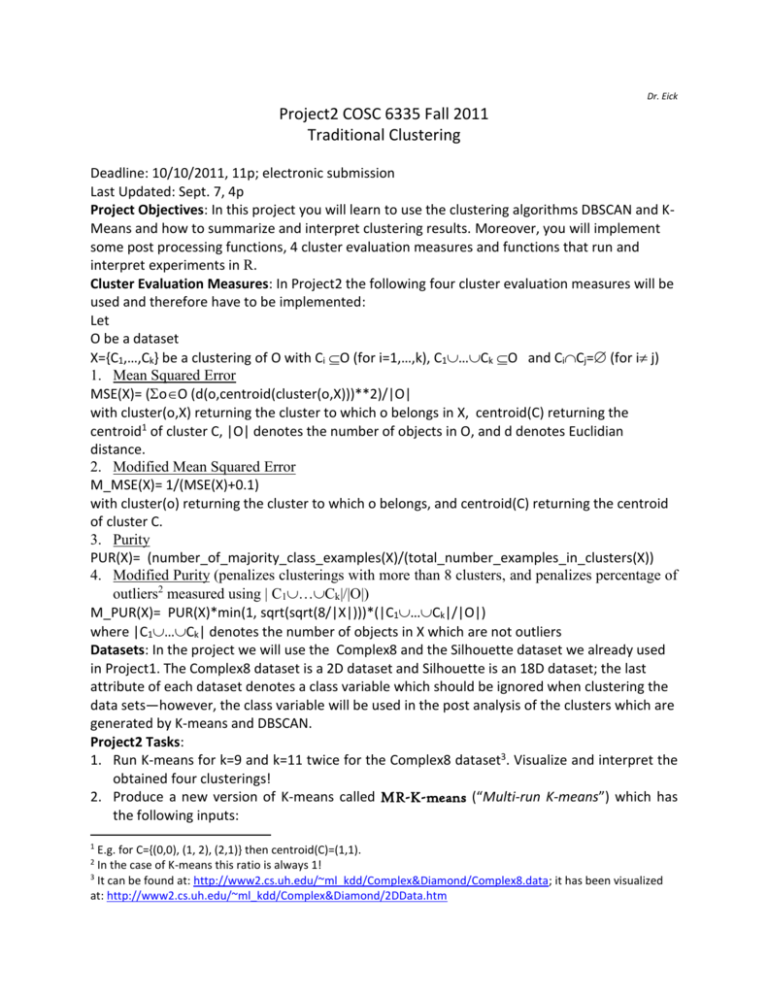
Dr. Eick
Project2 COSC 6335 Fall 2011
Traditional Clustering
Deadline: 10/10/2011, 11p; electronic submission
Last Updated: Sept. 7, 4p
Project Objectives: In this project you will learn to use the clustering algorithms DBSCAN and KMeans and how to summarize and interpret clustering results. Moreover, you will implement
some post processing functions, 4 cluster evaluation measures and functions that run and
interpret experiments in R.
Cluster Evaluation Measures: In Project2 the following four cluster evaluation measures will be
used and therefore have to be implemented:
Let
O be a dataset
X={C1,…,Ck} be a clustering of O with CiO (for i=1,…,k), C1…CkO and CiCj= (for i j)
1. Mean Squared Error
MSE(X)= (oO (d(o,centroid(cluster(o,X)))**2)/|O|
with cluster(o,X) returning the cluster to which o belongs in X, centroid(C) returning the
centroid1 of cluster C, |O| denotes the number of objects in O, and d denotes Euclidian
distance.
2. Modified Mean Squared Error
M_MSE(X)= 1/(MSE(X)+0.1)
with cluster(o) returning the cluster to which o belongs, and centroid(C) returning the centroid
of cluster C.
3. Purity
PUR(X)= (number_of_majority_class_examples(X)/(total_number_examples_in_clusters(X))
4. Modified Purity (penalizes clusterings with more than 8 clusters, and penalizes percentage of
outliers2 measured using | C1…Ck|/|O|)
M_PUR(X)= PUR(X)*min(1, sqrt(sqrt(8/|X|)))*(|C1…Ck|/|O|)
where |C1…Ck| denotes the number of objects in X which are not outliers
Datasets: In the project we will use the Complex8 and the Silhouette dataset we already used
in Project1. The Complex8 dataset is a 2D dataset and Silhouette is an 18D dataset; the last
attribute of each dataset denotes a class variable which should be ignored when clustering the
data sets—however, the class variable will be used in the post analysis of the clusters which are
generated by K-means and DBSCAN.
Project2 Tasks:
1. Run K-means for k=9 and k=11 twice for the Complex8 dataset3. Visualize and interpret the
obtained four clusterings!
2. Produce a new version of K-means called MR-K-means (“Multi-run K-means”) which has
the following inputs:
1
E.g. for C={(0,0), (1, 2), (2,1)} then centroid(C)=(1,1).
In the case of K-means this ratio is always 1!
3
It can be found at: http://www2.cs.uh.edu/~ml_kdd/Complex&Diamond/Complex8.data; it has been visualized
at: http://www2.cs.uh.edu/~ml_kdd/Complex&Diamond/2DData.htm
2
The number of clusters k (same as K-means)
A random number “meta seed” s (has the same type as the K-means seed)
A cluster evaluation measure eval (1, 2, 3 or 4 referring to the four clustering
evaluation measure introduced earlier)
MR-K-means runs K-means 10 times (with different seeds) obtaining clusterings X1,…,X10
returning the clustering Xi with the highest value for eval(Xi) as well as the maximum,
average, minimum value, and standard deviation of eval(X1),…,eval(X10).
3. Run MT-K-means with k=6 for the Silhouette dataset with the following two evaluation
measures:
M_MSE(X)
PUR(X)
Summarize and interpret the results obtainted in the two runs of MR-K-means!
4. Run DBSCAN for the Complex8 dataset for MinPoints=5 and for 3 different values for —try
to choose values for which lead to generating different clusters (e.g. having a different
number of clusters and/or outliers). Visualize and interpret the obtained results! Also
compare the clusters obtained with those obtained using K-means.
5. Run DBSCAN for the Silhouette dataset with a parameter settings which generates between
3 and 12 clusters4. Summarize the obtained DBSCAN clustering and compare its clusters
with those generated by K-means in Task3.
6. Find a parameter setting (a Minpoints--pair) for DBSCAN which generates a clustering
XBEST for the Complex8 dataset which has a very high value for M_PUR(XBEST). Report the
parameter setting you used, and visualize your “best” clustering and report its value for
M_PUR(XBEST) and PUR(XBEST). Moreover, describe how you obtained XBEST! Students
whose reported clustering XBEST has higher values for M_PUR(XBEST) receive more points
for Task6. Moreover, extra credit5 will be given to students who write a program which
automatically searches for the M_PUR-optimal clustering—by searching the “space of
possible DBSCAN parameter settings”—somewhat similar to the program which you wrote
for Task2.
Deliverables for Project2:
A. A Report6 which contains all deliverables for the six tasks of Project2.
B. A README file which describes how to run the MR-K-means program, and meta information
for other source code you delivered.
C. Other files which contain the source code of MR-K-means and other software you wrote as
part of this project.
4
Preferably 6 so that K-means and DBSCAN clustering results can be compared more easily—but this might not be
feasible!
5
The extra credit will be up to 10% of the points associated with Project2. No extra credit will be given to
erroneous programs for Task6.
6
Single-spaced; please use a 11-point or 12-point font!
